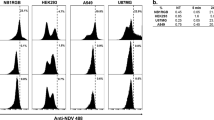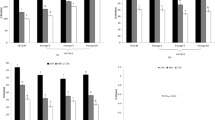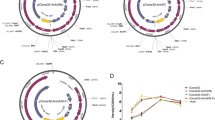Abstract
Newcastle disease virus (NDV), an avian paramyxovirus, has a potential oncolytic effect that may be of significance in the treatment of a variety of cancer diseases. An attenuated lentogenic isolate of NDV (HUJ) demonstrated a selective cytopathic effect upon a panel of human and mouse lung tumor cells, as compared to human nontumorigenic lung cells. The virus-selective oncolytic effect is apoptosis dependent, and related to higher levels of viral transcription, translation and progeny virus formation. Furthermore, NDV-HUJ oncolytic activity is directed in-cis and not through induction of cytokines, that may act in-trans on neighboring cells. Development of primary lung tumors and of the consequent metastasis in mice inoculated with mouse lung tumor cells 3LL-D122 was decreased following treatment with NDV-HUJ. The preferential killing of the tumor cells is not due to a deficiency in the interferon (IFN) system, as expression of the IFN-β gene, in the infected cells, is properly induced. Moreover, pretreatment with IFN effectively protected the tumor cells from the virus oncolytic effect. We conclude therefore, that NDV-HUJ should have a significant benefit in the treatment of lung cancer as well as other malignancies.
This is a preview of subscription content, access via your institution
Access options
Subscribe to this journal
Receive 12 print issues and online access
$259.00 per year
only $21.58 per issue
Buy this article
- Purchase on Springer Link
- Instant access to full article PDF
Prices may be subject to local taxes which are calculated during checkout








Similar content being viewed by others
References
Khuri FR, Herbst RS, Fossella FV . Emerging therapies in non-small-cell lung cancer. Ann Oncol 2001; 12: 739–744.
Vora SA, Daly BD, Blaszkowsky L, McGrath JJ, Bankoff M, Supran S et al. High dose radiation therapy and chemotherapy as induction treatment for stage III nonsmall cell lung carcinoma. Cancer 2000; 89: 1946–1952.
Elankumaran S, Rockemann D, Samal SK . Newcastle disease virus exerts oncolysis by both intrinsic and extrinsic caspase-dependent pathways of cell death. J Virol 2006; 80: 7522–7534.
Sinkovics JG, Horvath JC . Newcastle disease virus (NDV): brief history of its oncolytic strains. J Clin Virol 2000; 16: 1–15.
Tzadok-David Y, Metzkin-Eizenberg M, Zakay-Rones Z . The effect of a mesogenic and a lentogenic Newcastle disease virus strain on Burkitt lymphoma Daudi cells. J Cancer Res Clin Oncol 1995; 121: 169–174.
Csatary LK, Eckhardt S, Bukosza I, Czegledi F, Fenyvesi C, Gergely P et al. Attenuated veterinary virus vaccine for the treatment of cancer. Cancer Detect Prev 1993; 17: 619–627.
Csatary LK, Moss RW, Beuth J, Torocsik B, Szeberenyi J, Bakacs T . Beneficial treatment of patients with advanced cancer using a Newcastle disease virus vaccine (MTH-68/H). Anticancer Res 1999; 19: 635–638.
Freeman AI, Zakay-Rones Z, Gomori JM, Linetsky E, Rasooly L, Greenbaum E et al. Phase I/II trial of intravenous NDV-HUJ oncolytic virus in recurrent glioblastoma multiforme. Mol Ther 2006; 13: 221–228.
Schirrmacher V, Haas C, Bonifer R, Ertel C . Virus potentiation of tumor vaccine T-cell stimulatory capacity requires cell surface binding but not infection. Clin Cancer Res 1997; 3: 1135–1148.
Lorence RM, Katubig BB, Reichard KW, Reyes HM, Phuangsab A, Sassetti MD et al. Complete regression of human fibrosarcoma xenografts after local Newcastle disease virus therapy. Cancer Res 1994; 54: 6017–6021.
Schirrmacher V, Ahlert T, Probstle T, Steiner HH, Herold-Mende C, Gerhards R et al. Immunization with virus-modified tumor cells. Semin Oncol 1998; 25: 677–696.
Schirrmacher V, Jurianz K, Roth C, Griesbach A, Bonifer R, Zawatzky R . Tumor stimulator cell modification by infection with Newcastle disease virus: analysis of effects and mechanism in MLTC-CML cultures. Int J Oncol 1999; 14: 205–215.
Lorence RM, Rood PA, Kelley KW . Newcastle disease virus as an antineoplastic agent: induction of tumor necrosis factor-alpha and augmentation of its cytotoxicity. J Natl Cancer Inst 1988; 80: 1305–1312.
Zorn U, Dallmann I, Grosse J, Kirchner H, Poliwoda H, Atzpodien J . Induction of cytokines and cytotoxicity against tumor cells by Newcastle disease virus. Cancer Biother 1994; 9: 225–235.
Krishnamurthy S, Takimoto T, Scroggs RA, Portner A . Differentially regulated interferon response determines the outcome of Newcastle disease virus infection in normal and tumor cell lines. J Virol 2006; 80: 5145–5155.
Stojdl DF, Lichty B, Knowles S, Marius R, Atkins H, Sonenberg N et al. Exploiting tumor-specific defects in the interferon pathway with a previously unknown oncolytic virus. Nat Med 2000; 6: 821–825.
Stojdl DF, Lichty BD, tenOever BR, Paterson JM, Power AT, Knowles S et al. VSV strains with defects in their ability to shutdown innate immunity are potent systemic anti-cancer agents. Cancer Cell 2003; 4: 263–275.
Vermeulen K, Van Bockstaele DR, Berneman ZN . Apoptosis: mechanisms and relevance in cancer. Ann Hematol 2005; 84: 627–639.
Weaver BK, Ando O, Kumar KP, Reich NC . Apoptosis is promoted by the dsRNA-activated factor (DRAF1) during viral infection independent of the action of interferon or p53. FASEB J 2001; 15: 501–515.
Bar-Eli N, Giloh H, Schlesinger M, Zakay-Rones Z . Preferential cytotoxic effect of Newcastle disease virus on lymphoma cells. J Cancer Res Clin Oncol 1996; 122: 409–415.
Cheville NF, Beard CW . Cytopathology of Newcastle disease. The influence of bursal and thymic lymphoid systems in the chicken. Lab Invest 1972; 27: 129–143.
Hitchner SB, Johnson EP . A virus of low virulence for immunizing fowls against Newcastle disease (avian pneumoencephalitis). Vet Med 1948; 43: 525–530.
Wagner S, Csatary CM, Gosztonyi G, Koch HC, Hartmann C, Peters O et al. Combined treatment of pediatric high-grade glioma with the oncolytic viral strain MTH-68/H and oral valproic acid. APMIS 2006; 114: 731–743.
Giard DJ, Aaronson SA, Todaro GJ, Arnstein P, Kersey JH, Dosik H et al. In vitro cultivation of human tumors: establishment of cell lines derived from a series of solid tumors. J Natl Cancer Inst 973; 51: 1417–1423.
Jacobs JP, Jones CM, Baille JP . Characteristics of a human diploid cell designated MRC-5. Nature 1970; 227: 168–170.
Machlenkin A, Goldberger O, Tirosh B, Paz A, Volovitz I, Bar-Haim E et al. Combined dendritic cell cryotherapy of tumor induces systemic antimetastatic immunity. Clin Cancer Res 2005; 11: 4955–4961.
Sever JL . Application of a microtechnique to viral serological investigations. J Immunol 1962; 88: 320–329.
Zhou YH, Wu X, Tan F, Shi YX, Glass T, Liu TJ et al. PAX6 suppresses growth of human glioblastoma cells. J Neurooncol 2005; 71: 223–229.
Darash-Yahana M, Pikarsky E, Abramovitch R, Zeira E, Pal B, Karplus R et al. Role of high expression levels of CXCR4 in tumor growth, vascularization, and metastasis. FASEB J 2004; 18: 1240–1242.
Pitha PM, Kunzi MS . Type I interferon: the ever unfolding story. Curr Top Microbiol Immunol 2007; 316: 41–70.
Darzynkiewicz Z, Bedner E, Smolewski P . Flow cytometry in analysis of cell cycle and apoptosis. Semin Hematol 2001; 38: 179–193.
Hande KR . Etoposide: four decades of development of a topoisomerase II inhibitor. Eur J Cancer 1998; 34: 1514–1521.
Matza-Porges S, Horresh I, Tavor E, Panet A, Honigman A . Expression of an anti apoptotic recombinant short peptide in mammalian cells. Apoptosis 2005; 10: 987–996.
Nagai Y . Paramyxovirus replication and pathogenesis. Reverse genetics transforms understanding. Rev Med Virol 1999; 9: 83–99.
Castagnetta LA, Carruba G . Human prostate cancer: a direct role for oestrogens. Ciba Found Symp 1995; 191: 269–286.
Peeters BP, de Leeuw OS, Koch G, Gielkens AL . Rescue of Newcastle disease virus from cloned cDNA: evidence that cleavability of the fusion protein is a major determinant for virulence. J Virol 1999; 73: 5001–5009.
Romer-Oberdorfer A, Werner O, Veits J, Mebatsion T, Mettenleiter TC . Contribution of the length of the HN protein and the sequence of the F protein cleavage site to Newcastle disease virus pathogenicity. J Gen Virol 2003; 84 (Partt 11): 3121–3129.
Fiola C, Peeters B, Fournier P, Arnold A, Bucur M, Schirrmacher V . Tumor selective replication of Newcastle disease virus: association with defects of tumor cells in antiviral defence. Int J Cancer 2006; 119: 328–338.
Park MS, Garcia-Sastre A, Cros JF, Basler CF, Palese P . Newcastle disease virus V protein is a determinant of host range restriction. J Virol 2003; 77: 9522–9532.
Park MS, Shaw ML, Munoz-Jordan J, Cros JF, Nakaya T, Bouvier N et al. Newcastle disease virus (NDV)-based assay demonstrates interferon-antagonist activity for the NDV V protein and the Nipah virus V, W, and C proteins. J Virol 2003; 77: 1501–1511.
Apostolidis L, Schirrmacher V, Fournier P . Host mediated anti-tumor effect of oncolytic Newcastle disease virus after locoregional application. Int J Oncol 2007; 31: 1009–1019.
Fabian Z, Csatary CM, Szeberenyi J, Csatary LK . p53-Independent endoplasmic reticulum stress-mediated cytotoxicity of a Newcastle disease virus strain in tumor cell lines. J Virol 2007; 81: 2817–2830.
Pecora AL, Rizvi N, Cohen GI, Meropol NJ, Sterman D, Marshall JL et al. Phase I trial of intravenous administration of PV701, an oncolytic virus, in patients with advanced solid cancers. J Clin Oncol 2002; 20: 2251–2266.
Hotte SJ, Lorence RM, Hirte HW, Polawski SR, Bamat MK, O’Neil JD et al. An optimized clinical regimen for the oncolytic virus PV701. Clin Cancer Res 2007; 13: 977–985.
Kido H, Yokogoshi Y, Sakai K, Tashiro M, Kishino Y, Fukutomi A et al. Isolation and characterization of a novel trypsin-like protease found in rat bronchiolar epithelial Clara cells. A possible activator of the viral fusion glycoprotein. J Biol Chem 1992; 267: 13573–13579.
Stram Y, Shchori D, Chinitch Y, David D, Molad T, Samina I . Molecular characterization of an unassigned Israeli Newcastle disease virus isolate. Avian Dis 1998; 42: 746–751.
Reed LJ, Muench HA . A simple method of estimating fifty percent endpoints. Am J Hyg 1938; 27: 493–497.
Aymard-Henry M, Coleman MT, Dowdle WR, Laver WG, Schild GC, Webster RG . Influenzavirus neuraminidase and neuraminidase-inhibition test procedures. Bull World Health Organ 1973; 48: 199–202.
Luther P, Klett GE, Weber S, Pechmann H, Bergmann KC . The lectin neuraminidase inhibition test: a new method for the detection of antibodies to neuraminidase. J Biol Stand 1983; 11: 115–121.
Gotoh BYF, Ogasawara T, Nagai Y . Isolation of factor Xa from chick embryo as the amniotic endoprotease responsible for paramyxovirus activation. FEBS Lett 1992; 296: 274–278.
Acknowledgements
This work was supported by grant from the Philip Morris US and international external research program and by a grant of the European commission, program number 6. The Cinigene Network of excellence. The ICPI assay was performed by Dr I Samina, The Veterinary Institute, Bet Dagan, Israel.
Author information
Authors and Affiliations
Corresponding author
Additional information
Supplementary Information accompanies the paper on Cancer Gene Therapy website (http://www.nature.com/cgt)
Supplementary information
Rights and permissions
About this article
Cite this article
Yaacov, B., Elihaoo, E., lazar, I. et al. Selective oncolytic effect of an attenuated Newcastle disease virus (NDV-HUJ) in lung tumors. Cancer Gene Ther 15, 795–807 (2008). https://doi.org/10.1038/cgt.2008.31
Received:
Revised:
Accepted:
Published:
Issue Date:
DOI: https://doi.org/10.1038/cgt.2008.31
Keywords
This article is cited by
-
The phosphatase and tensin homolog gene inserted between NP and P gene of recombinant Newcastle disease virus oncolytic effect test to glioblastoma cell and xenograft mouse model
Virology Journal (2022)
-
Oncolytic Newcastle disease virus delivered by Mesenchymal stem cells-engineered system enhances the therapeutic effects altering tumor microenvironment
Virology Journal (2020)
-
Regression of solid breast tumours in mice by Newcastle disease virus is associated with production of apoptosis related-cytokines
BMC Cancer (2019)
-
Antiviral interferons induced by Newcastle disease virus (NDV) drive a tumor-selective apoptosis
Scientific Reports (2019)
-
Oncolytic virus immunotherapy: future prospects for oncology
Journal for ImmunoTherapy of Cancer (2018)



